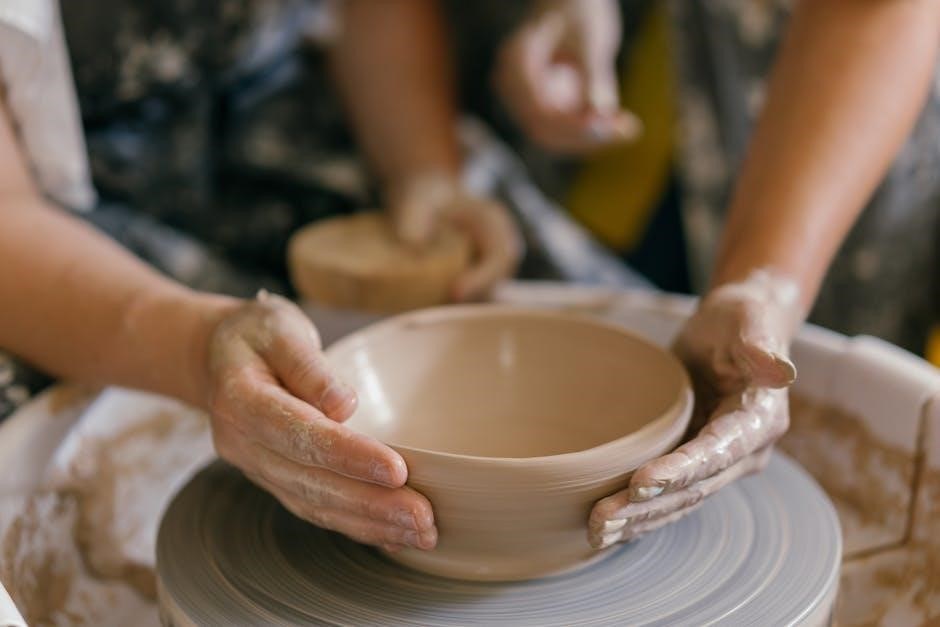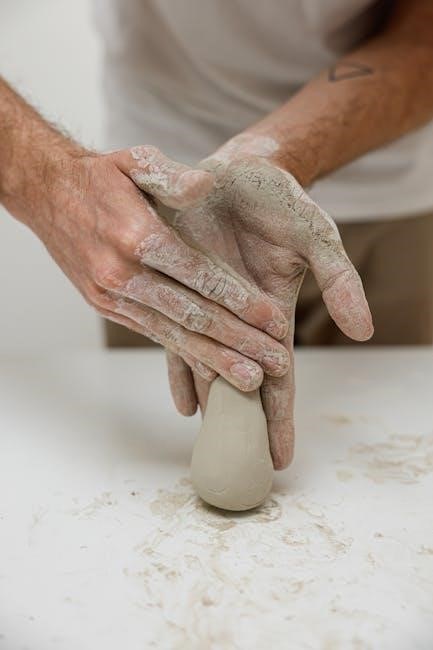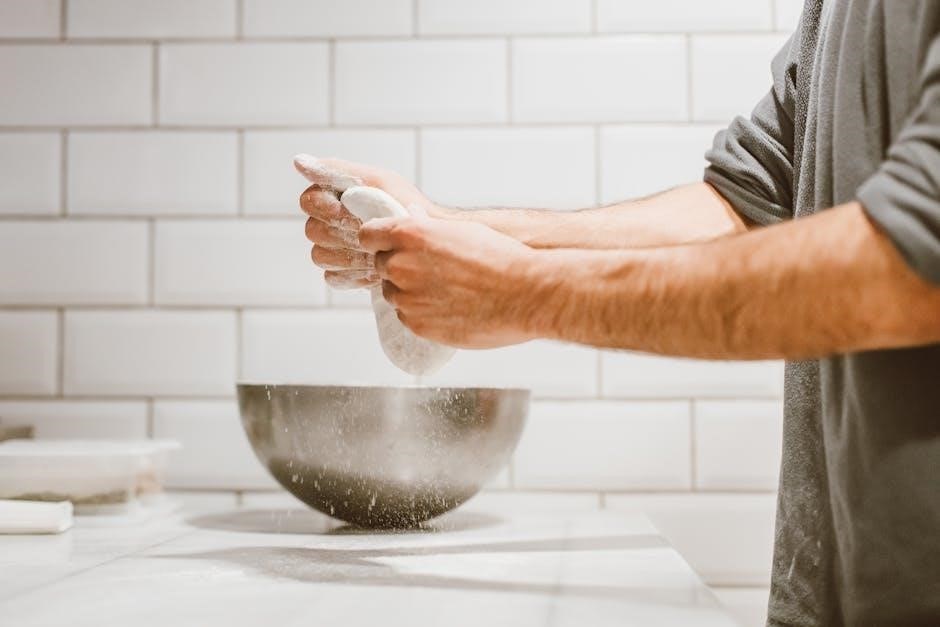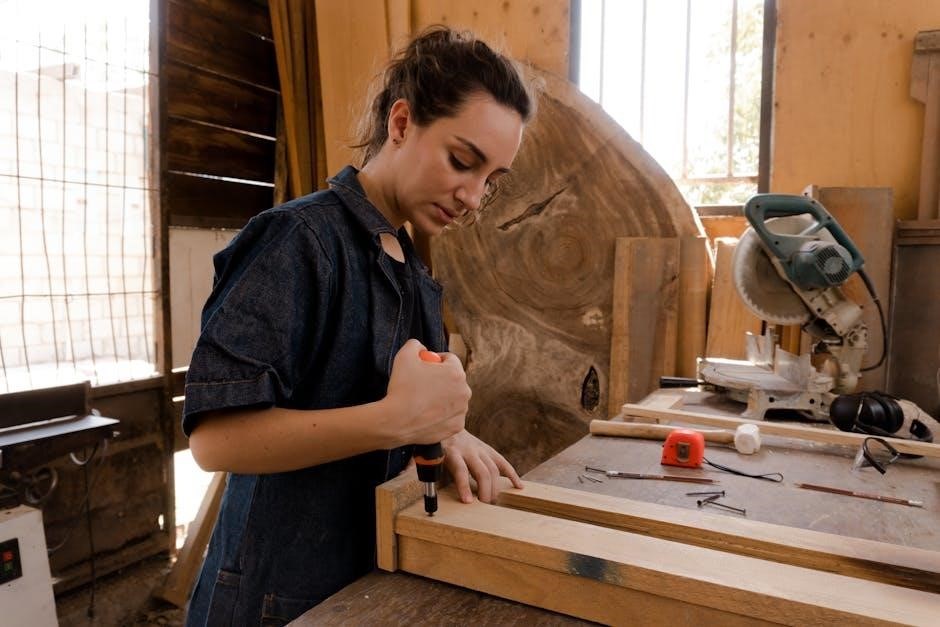Welcome to the Panasonic Bread Maker Instruction Manual! This guide provides essential information for using and maintaining your appliance, ensuring safe and efficient bread making.
Overview of the Panasonic Bread Maker Models
Panasonic offers a range of bread maker models, including the SD-YD150, SD2511, and SD257, each designed for household use. These models feature multiple settings for bread types, crust colors, and baking options. The SD-YD150 boasts 31 settings, while the SD2511 and SD257 provide similar versatility. All models include accessories like a bread pan and measuring cups, ensuring ease of use. With their sturdy design and advanced features, Panasonic bread makers cater to both novice and experienced bakers, offering a reliable way to create fresh, homemade bread with minimal effort. These models are known for their durability and user-friendly interfaces.
Importance of Reading the Instruction Manual
Reading the instruction manual is crucial for safe and effective use of your Panasonic bread maker. It provides detailed safety guidelines, operating instructions, and troubleshooting tips. The manual helps you understand the appliance’s features, such as multiple settings for bread types and crust colors. By following the instructions, you can avoid potential hazards and ensure optimal performance. It also offers guidance on maintenance, cleaning, and accessory usage, helping you extend the product’s lifespan. Referencing the manual allows you to make the most of your bread maker’s capabilities and achieve consistent, high-quality baking results. Always keep it handy for future reference.

Safety Instructions and Precautions
Always follow safety guidelines to prevent accidents. Keep children away, avoid hot surfaces, and unplug the appliance when not in use. Use oven mitts for handling.
General Safety Guidelines
Always prioritize safety when using your Panasonic bread maker. Place the appliance on a stable, heat-resistant surface away from water sources. Avoid touching hot surfaces, and never insert metal objects into the machine. Keep children away during operation. Ensure proper ventilation to prevent moisture buildup. Unplug the bread maker when not in use or during cleaning. Avoid overloading the bread pan, as this can cause imbalance. Use oven mitts or tongs to handle the bread pan or baked bread. Regularly inspect the power cord and plug for damage. Follow all instructions carefully to prevent accidents and ensure optimal performance.
Do’s and Don’ts for Safe Operation
Always read the manual before first use and follow instructions carefully. Use the bread maker on a flat, dry surface. Ensure all ingredients are at room temperature unless specified. Avoid overloading the bread pan, as this can disrupt operation. Keep the appliance away from flammable materials. Never leave the bread maker unattended during operation. Use a non-abrasive cleaner for maintenance. Avoid using metal tools near electrical parts. Do not submerge the bread pan or electrical components in water. Follow recommended ingredient measurements to prevent overflow. Regularly clean crumbs from the bread pan to maintain hygiene and performance.
Handling Electrical Components Safely
Always handle electrical components with care to avoid damage or injury. Ensure the power cord is not damaged, knotted, or stretched excessively. Plug the bread maker into a grounded outlet with the correct voltage rating. Never expose electrical parts to water or moisture, as this can cause short circuits. Avoid touching electrical components with wet hands. If repairs are needed, disconnect the appliance from power first. Regularly inspect the cord and plug for wear and tear. Store the bread maker in a dry place when not in use. Use only original or recommended replacement parts for electrical components. Always unplug the appliance before cleaning or maintaining it.

Understanding the Bread Maker Components
Understanding the bread maker components is essential for proper operation. Familiarize yourself with the bread pan, paddles, control panel, and additional accessories to ensure efficient and safe use.
Accessories and Parts Identification
Identify the bread maker’s accessories and parts to ensure proper assembly and function. Key components include the bread pan, paddles, measuring cup, and spoon. Additional accessories may vary by model, such as a power cord, crust control knob, or yeast dispenser. Familiarize yourself with each part’s purpose to optimize usage. Refer to the manual for diagrams that illustrate each component’s location and function. Proper identification helps prevent errors during operation and ensures all parts are used correctly for consistent bread-making results. Always store accessories safely to maintain their condition and longevity.
Key Features of Panasonic Bread Makers
Panasonic bread makers are equipped with advanced features designed for convenience and versatility. They include programmable timers, adjustable loaf sizes, and multiple baking modes to cater to various bread types. Many models come with a yeast-proofing function, ensuring optimal dough rise. Crust color control allows customization, while non-stick pans facilitate easy bread removal. Some units also feature a keep-warm function to maintain freshness. These features enhance the bread-making experience, offering precision and flexibility for both novice and experienced bakers. They ensure consistent results and accommodate diverse preferences, making Panasonic bread makers a reliable choice for home use.
Model-Specific Components (e.g., SD-YD150, SD2511, SD257)
Each Panasonic bread maker model offers distinct components tailored to specific needs. The SD-YD150 features a large capacity and dual paddles for efficient mixing. The SD2511 includes a user-friendly interface and a compact design, ideal for smaller kitchens. The SD257 boasts advanced temperature control and a robust motor for heavy-duty use. These models also have variations in bread pan sizes and shapes, ensuring versatility in bread types. Understanding these model-specific components helps users maximize their appliance’s potential and achieve consistent baking results.

Setting Up Your Bread Maker
Setting up your Panasonic bread maker involves unboxing, placing it on a stable surface, installing the bread pan, and ensuring proper levelling. Plug in the appliance safely and refer to the manual for specific model instructions.
Unboxing and Initial Setup
Begin by carefully opening the box and inspecting all contents, including the bread maker, bread pan, kneading blade, and additional accessories. Ensure no damage occurred during shipping. Place the appliance on a stable, heat-resistant surface away from direct sunlight and water sources. Remove any packaging materials and protective covers. Before first use, wash the bread pan and kneading blade with mild soap and rinse thoroughly. Dry all parts and reassemble them according to the manual. Plug in the bread maker and ensure the power cord is securely connected. Refer to the manual for model-specific setup instructions to ensure proper initialization.
Placing the Appliance on a Stable Surface
To ensure safe and efficient operation, place the Panasonic bread maker on a stable, flat, and heat-resistant surface. Avoid uneven or wobbly surfaces, as this could disrupt the balance of the appliance during operation. Choose a location away from direct sunlight, water sources, or flammable materials to minimize risks. Ensure the surface is clean and dry before positioning the bread maker. Additionally, maintain at least 10 cm of clearance around the appliance for proper ventilation. Never place the bread maker near open flames or in areas prone to moisture accumulation, as this could damage the electrical components or compromise safety.
Installing the Bread Pan and Other Accessories
Before using your Panasonic bread maker, ensure the bread pan and accessories are properly installed. Align the bread pan with the machine’s interior guides and gently push it down until it clicks into place. Handle the kneading blade with care to avoid injury and ensure it is securely attached to the bread pan. Other accessories, such as measuring cups and spoons, should be stored nearby for easy access. For first-time users, lightly oil the bread pan and blade to prevent sticking. Always refer to the manual for specific installation instructions tailored to your model to guarantee proper assembly and functionality.

Operating the Bread Maker
Press the menu button to select desired settings, then choose ingredients and program. Start the machine and let it handle mixing, kneading, and baking automatically.
Basic Operation Steps
Start by plugging in the bread maker and ensuring it’s placed on a stable surface. Press the power button to turn it on. Use the control panel to select your desired bread-making mode, such as basic, whole wheat, or rapid bake. Choose the loaf size and crust color using the corresponding buttons. Set the timer if needed and press the start button to begin the cycle. The machine will automatically handle mixing, kneading, rising, and baking. Always refer to the manual for model-specific instructions. Ensure all electrical components are handled safely to avoid accidents.
Advanced Settings and Customization Options
Panasonic bread makers offer advanced features for tailored baking experiences. Users can customize settings like delay timers, yeast proofing, and crust colors. Adjustable loaf sizes and programmable memory settings allow saving favorite recipes. The LCD display provides clear navigation for selecting modes, such as gluten-free or sourdough. Utilize the menu to fine-tune settings with +/- buttons for precise control. Explore additional modes for jam, cake, or pasta dough. These options empower users to experiment beyond basic recipes, ensuring versatility and creativity in their bread-making journey. Always refer to the manual for model-specific customization details.
Troubleshooting Common Issues
If your Panasonic bread maker encounters issues, start by checking power supply and ensuring the bread pan is properly locked. Common problems include uneven mixing, bread not baking fully, or the machine stopping mid-cycle; Check for incorrect ingredient measurements or expired yeast, as these can affect rise. Ensure the pan is aligned correctly to avoid jamming. Reset the machine by unplugging it for 30 seconds if it malfunctions. Refer to the error code list in the manual for specific solutions. Regular cleaning and lubrication of moving parts can prevent operational issues. Always unplug the unit before attempting repairs.
Maintenance and Cleaning Tips
Regular maintenance ensures optimal performance of your Panasonic bread maker. After each use, unplug the machine and let it cool before cleaning. Wipe the exterior with a damp cloth and avoid harsh chemicals. The bread pan and kneading blade should be washed with mild soap and dried thoroughly. occasionally, lubricate moving parts like the pan lock and hinges to prevent rust. For tough dough residue, soak the pan in warm water before cleaning. Always dry the interior thoroughly to prevent mold. Regularly check and replace worn-out seals or parts to maintain efficiency and hygiene.

Bread Making Process

The bread making process involves measuring ingredients, loading them into the bread pan, selecting the appropriate program, and monitoring the machine as it mixes, kneads, and bakes.
Preparing Ingredients and Measuring
Accurate ingredient measurement is crucial for optimal bread making. Use a digital kitchen scale for precise measurements, especially for flour, yeast, and salt. Measure liquids using a clear measuring cup, ensuring the meniscus aligns with the desired level. Sift flour to remove lumps and ensure even distribution. Yeast must be fresh and stored properly to activate effectively. Always use room-temperature ingredients unless specified otherwise; Correct measurements ensure the right balance of ingredients, leading to proper dough formation and a perfectly baked loaf. This step sets the foundation for a successful bread-making process.
Loading the Ingredients into the Bread Pan
Always load ingredients into the bread pan in the correct order to ensure proper mixing. Typically, liquids (water, milk, or eggs) go first, followed by dry ingredients like flour, sugar, and salt. Yeast should be placed on top of the dry ingredients to avoid direct contact with liquids. Add any optional ingredients, such as nuts or seeds, in the designated compartment if available. Properly align the bread pan in the machine and secure it firmly to prevent shifting during operation. This ensures even distribution and proper functionality of the bread maker.
Selecting the Right Program for Your Bread
Your Panasonic bread maker offers various preset programs designed for different types of bread, such as basic, whole wheat, French, gluten-free, and sourdough. Each program adjusts temperature, rising time, and baking duration to suit the recipe. For example, the basic program is ideal for standard white bread, while the whole wheat program ensures a longer kneading cycle for denser loaves. Review the user manual to understand the specific settings for each program. Choose the program that matches your recipe and bread type for the best results. Adjusting the program ensures optimal texture and flavor for your homemade bread.
Monitoring the Bread Making Cycle
Monitoring your Panasonic bread maker during operation ensures your bread turns out perfectly. The machine features a digital display that shows the current stage of the cycle, from kneading to baking. Use the viewing window to observe dough development without opening the lid. Avoid frequent lid opening to prevent heat loss, which can affect rising. Set a timer based on the cycle duration provided in the manual. Some models also have audible signals to notify you of progress. Regularly check the machine to ensure it operates smoothly and adjust settings if necessary. Proper monitoring guarantees a perfectly baked loaf every time.

Recipes and Baking Options
Panasonic bread makers offer versatile baking options, including whole-grain, sourdough, and gluten-free recipes. Users can also make dough, pasta, or jam with customizable settings for crust color and texture.
Basic Bread Recipes
The Panasonic bread maker simplifies creating delicious homemade bread with pre-programmed settings for classic recipes. Start with basic white bread using flour, yeast, salt, sugar, and water. For whole wheat, add bran or whole-grain flour for a nuttier flavor. Rye bread can be made by adjusting the flour ratio and adding caraway seeds. Simply measure ingredients, pour into the bread pan, and select the appropriate program. The machine handles mixing, kneading, and baking. Use the crust color option to achieve your preferred texture. These recipes are perfect for beginners, ensuring fresh, homemade bread with minimal effort and cleanup.
Gluten-Free and Special Diet Options
The Panasonic bread maker supports gluten-free and special diet needs with customizable programs. For gluten-free bread, use gluten-free flours like rice or almond flour and adjust liquid content. The machine’s gluten-free setting ensures proper mixing and baking. Additionally, users can create vegan, low-carb, or sugar-free bread by substituting ingredients like eggs or dairy. Experiment with yeast-free options for quicker recipes. Always consult the manual for specific settings and ingredient ratios. This versatility makes the Panasonic bread maker ideal for diverse dietary requirements, offering fresh, tailored bread with ease and precision.
Customizing Recipes for Different Bread Types
Customizing recipes for various bread types is easy with Panasonic bread makers. For whole wheat bread, increase the yeast and water slightly. When making sourdough, use a sourdough starter instead of commercial yeast. Rye bread may require caraway seeds and a darker crust setting. Experiment with add-ins like herbs, nuts, or cheese for unique flavors. Adjust ingredient ratios and baking times as needed for different loaf sizes. The machine’s customizable programs, such as the yeast-proofing function, ensure optimal results. By tweaking recipes and settings, you can create a wide variety of breads tailored to your preferences and dietary needs with precision and ease.

Common Issues and Solutions
Address common issues like uneven baking or dough not rising by checking yeast expiration, ensuring accurate measurements, and verifying the machine is level. Resolve error codes by consulting the manual or resetting the device. Regularly clean the bread pan and crust tray to prevent residue buildup. If the machine stops mid-cycle, unplug, wait, and restart. For consistent results, follow recipe guidelines and adjust settings as needed. Proper maintenance and adherence to instructions minimize issues and extend appliance longevity. Always refer to the troubleshooting guide for specific solutions.
Resolving Error Messages
If your Panasonic bread maker displays an error message like E01 or E02, it indicates a specific issue. Refer to the manual to understand the code meaning; Common errors include power interruptions, sensor malfunctions, or improper pan placement. To resolve, unplug the machine, wait 30 seconds, and restart. Ensure all connections are secure and the bread pan is correctly aligned. For persistent issues, clean the crust tray and bread pan thoroughly, as residue can trigger errors. Always consult the troubleshooting section in the manual for code-specific solutions to restore proper function and avoid further disruptions.
Fixing Issues with Bread Texture or Crust
If your bread turns out dense, soggy, or with an uneven crust, check your ingredient measurements and dough consistency. Ensure yeast is fresh and activate it properly before mixing. Too much flour can lead to dense bread, while insufficient salt may cause poor texture. For a crispy crust, select the crust color option and ensure proper ventilation around the machine. Avoid opening the lid during baking, as this disrupts crust formation. Adjusting temperature settings or adding a cool-down phase can also improve results. Experiment with recipes and settings to achieve the perfect texture and crust for your bread. Proper technique and precise measurements are key.
Dealing with Jammed or Stuck Parts
If your Panasonic bread maker has jammed or stuck parts, such as the bread pan or paddles, unplug the appliance first for safety. Gently remove any dough or debris using a soft brush or damp cloth. Ensure the bread pan is properly aligned and clicked into place before operation. Avoid forcing parts, as this may cause damage. Regularly cleaning the machine, especially after use, can prevent jams. If issues persist, consult the manual or contact Panasonic support for assistance. Proper maintenance and handling will extend the life of your bread maker. Always follow the manufacturer’s guidelines for troubleshooting.

Additional Resources and Support
For further assistance, visit the Panasonic support website. Explore user manuals, FAQs, and contact options for personalized help. Additionally, join our community forum for tips and troubleshooting.
Downloading the Full Instruction Manual
To access the full Panasonic bread maker instruction manual, visit the official Panasonic support website. Navigate to the “Support” or “Downloads” section and search for your specific bread maker model. Enter your model number, such as SD-YD150 or SD2511, to find the corresponding manual. Download the PDF version for easy reference. If you’re unable to locate your model, contact Panasonic customer support for assistance. Ensure you have Adobe Acrobat Reader installed to view the manual. This resource provides detailed instructions, troubleshooting guides, and warranty information to help you make the most of your bread maker.
Accessing Panasonic Customer Support
To access Panasonic customer support, visit their official website and navigate to the “Support” section. Select your product category and model to find dedicated assistance. You can contact their team via phone, email, or live chat for inquiries or issues. Additionally, the website offers FAQs, troubleshooting guides, and repair service options. For bread maker-specific support, ensure you have your model number ready, such as SD-YD150 or SD2511. Panasonic also provides regional support pages, so check your local website for tailored assistance. This resource helps resolve technical issues and ensures optimal use of your appliance.
Finding Online Tutorials and Guides
To enhance your experience with the Panasonic bread maker, numerous online resources are available. Visit Panasonic’s official website for downloadable manuals, video tutorials, and user guides tailored to your specific model. Platforms like YouTube and forums often feature step-by-step demonstrations and tips from experienced users. Additionally, Panasonic may provide model-specific guides, such as for the SD-YD150 or SD2511, to help you master advanced features. Use search keywords like “Panasonic bread maker tutorial” or “SD-YD150 guide” to find relevant content. These resources can help troubleshoot issues and inspire new recipes, ensuring you get the most out of your appliance.
Final Tips for Optimal Use
To get the most from your Panasonic bread maker, experiment with recipes, explore custom settings, and maintain the appliance regularly; Clean the bread pan and blades after each use to prevent residue buildup. Store the machine in a dry place when not in use. Don’t hesitate to try new ingredients or adjust timings for personalized results. Refer to the manual for troubleshooting tips, and take advantage of optional features like timers or yeast proofing. Happy baking, and enjoy the convenience of fresh, homemade bread with your Panasonic bread maker!
Encouragement to Experiment and Explore
Don’t be afraid to explore beyond basic recipes! Your Panasonic bread maker is a versatile tool designed to inspire creativity. Try experimenting with different flours, herbs, and spices to craft unique bread varieties. Gluten-free options, sourdough, and even sweet breads are within your reach. Customize settings to achieve the perfect crust and texture. Remember, baking is a journey of discovery—embrace trial and error to refine your skills. With practice, you’ll unlock endless possibilities and enjoy the satisfaction of creating personalized, delicious bread tailored to your taste preferences. Happy experimenting and baking!
